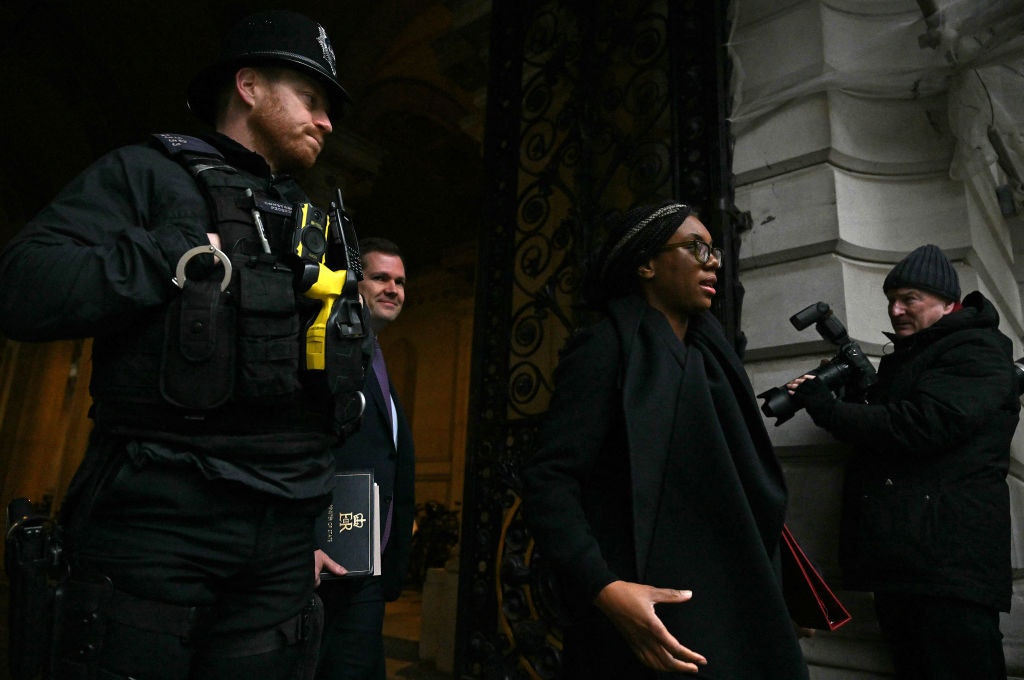Clothes maketh the nation
How servants of the Crown dress is not trivial. It reflects Britain’s decline
This article is taken from the October 2023 issue of The Critic. To get the full magazine why not subscribe? Right now we’re offering five issues for just £10.
As the fury over the Government’s Rwanda scheme calms down, at least temporarily, after the Court of Appeal gave its ruling in June, I thought it might be safe to dip a toe into a side-angle of that ruling, which may, at first glance, appear trivial.
One consequence of these judgments now being televised is that we ordinary members of the public can see the vesture now worn by the judiciary when hearing civil cases. They are revolting. They appear to be made out of polyester, or if not polyester, they have managed to find material that certainly looked like polyester.
The judicial bands, so long the mark of civic and academic distinction, are no longer the white of every other institution and jurisdiction, but a livid yellow. These don’t hang freely but are sewn onto the robes, and are in a neat line so that it rather looked like the Lord Chief Justice’s head was parked on a double yellow line. His head, of course, was bare, unadorned by the wig which should mark out his office.
How did this happen? It was introduced in 2008 by a reforming Lord Chief Justice having recruited some fashionista called Betty Jackson to create this dog’s breakfast of a uniform, and was cheered on by the Guardian as bringing “the judges at least part of the way into the 21st century”. The Guardian was out by two centuries: this was not Cool Britannia, this was the starship Enterprise.
How agents of the state look directly affects how citizens interact with the state
On one level I can’t really blame the Conservative administration for not reversing this in its 13 years of office. This was a decision that previous governments had delegated to the senior judiciary to work out for itself. It also will no doubt feel that what people wear is too trivial a matter for a government to take an interest in. Both of these mindsets demonstrate exactly why much is wrong in Britain today.
How agents of the state look directly affects how citizens interact with the state. Decisions over how the United Kingdom projects its image, at home and abroad, are not trivial. They say a great deal consciously and subconsciously.
Take the armed forces, another institution whose uniforms have been transformed recently — this time during the time the Conservative Party has held office. Except for the smartest of occasions, our soldiers, sailors, and members of the RAF seem to be dressed in dungarees.
Not just when at risk of engaging the enemy (nobody’s suggesting smartness is a relevant criterion in battle) but these trashy outfits are worn while giving interviews, when welcoming foreign dignitaries onto ships, while on parade, and even when Daniel Craig was made an honorary Commander by the First Sea Lord (whose chances of engaging with the enemy must be pretty low).
When these uniforms were unveiled and met with a wall of derision, the government made it clear that such matters were below them; these were not political decisions but a mere logistical question.
The same, of course, is true in the transformation of police officers into tieless, flat-cap wearing, borderline-paramilitaries. This affects how the citizens relate to them, and takes us another step away from the perception of the old policing by consent.
How our armed forces look, especially when abroad, especially when in the media, matters
Which is why this should be a government decision. How our armed forces look, especially when abroad, especially when in the media, matters. How our police look, how the judiciary looks, matters. It talks of how we see ourselves and our relationship to the state and the laws which need to be enforced.
When you’re representing the British Crown, what you wear says something about the dignity and power of that Crown. What the servants of the Crown wear is properly a matter for the Government, because it is for the Government to determine how Britain and its agents present themselves within the nation and to the wider world.
But this reflects a deeper issue: that government has been devolved to quangos, and that decisions of this middling sort are not taken by anyone with political authority. This shifts the feel and nature of the nation without the nation having even nominal say over it.
How a nation looks and feels is not, in fact, trivial. It reflects the tastes and undergirding philosophy of those who make these, but also much more important, decisions. It’s probably too late to reverse Britain’s aesthetic decline, but there is at least a year-and-a-half left of this government and maybe a small part of their legacy might be a properly conservative concern for how the nation is run and at least a part of that should be to ensure that those who do run it are those who can be held properly to account.
Whether they, in turn, have taste, is a matter for the electorate.
Enjoying The Critic online? It's even better in print
Try five issues of Britain’s most civilised magazine for £10
Subscribe














